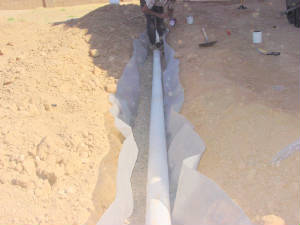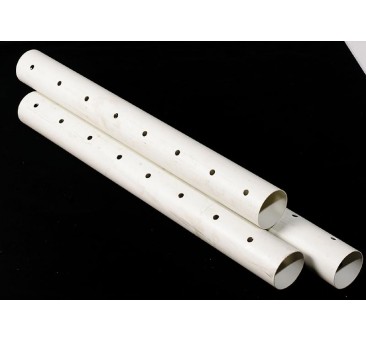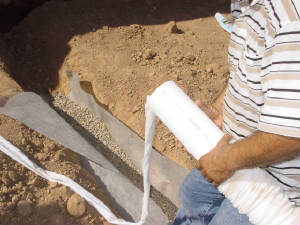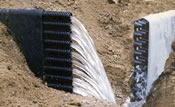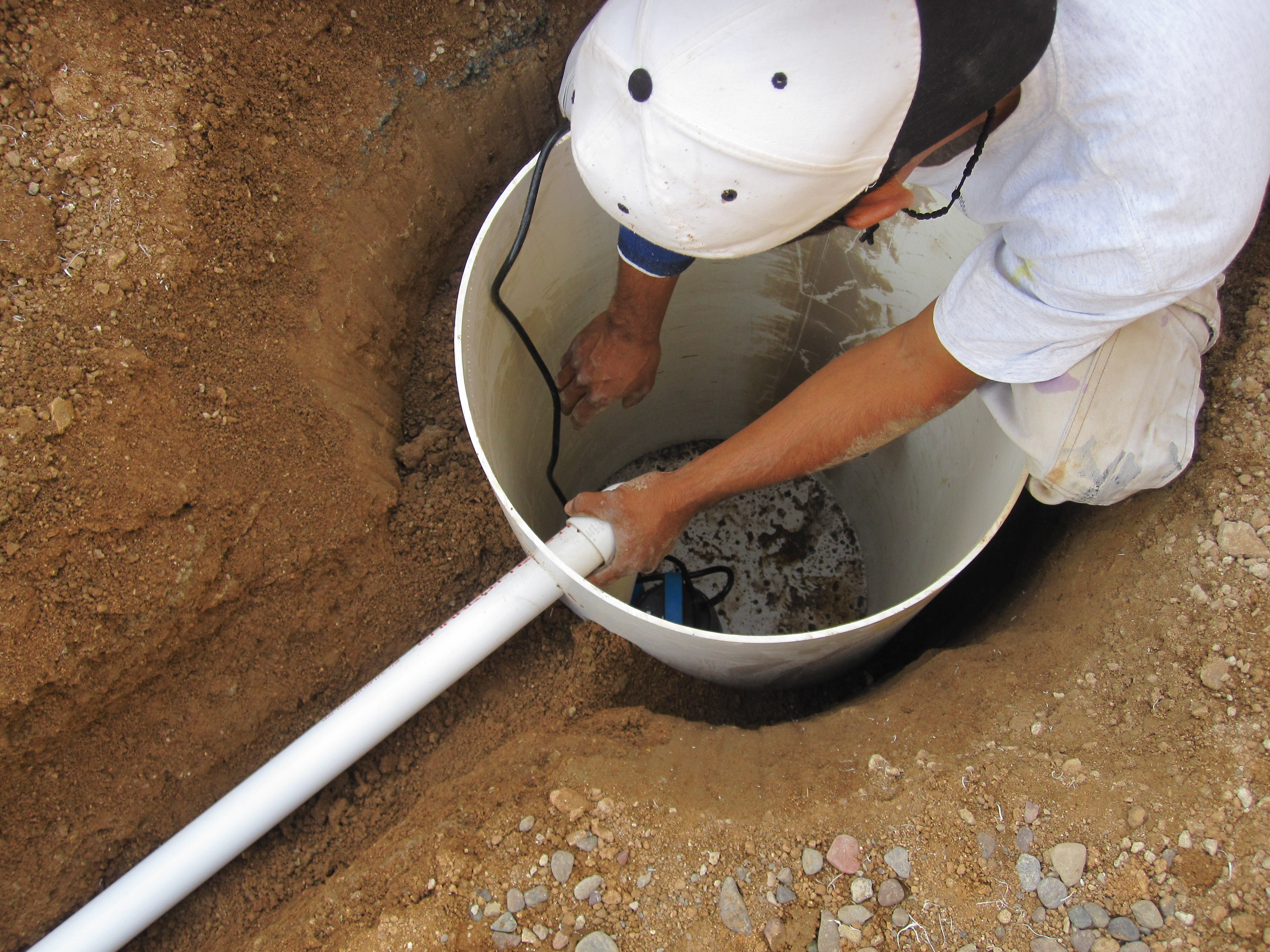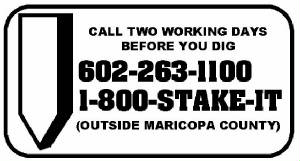|
|
Home/ServicesAbout UsDrainage Tips For HomeownersWhat is Expansive Soil? Map of Expansive soils in Metropolitan PhoenixDrainage System ComponetsRain GuttersFoundation RepairFAQ Answer PagePost tension slab videoTestimonialsLandscape Drainage Solutions Service AreaRequest ConsultationContact UsHave A Comment or Question?BlogJob Openings
|
Q: What is a French Drain?
A: French Drains are usually Plastic drain pipe with holes in it to collect subsurface water & divert it from your homes foundation. There is a "sock" or filter fabric that fits over the pipe to prevent soil from entering the holes & clogging the pipe rendering it un-operable. The pipe is set in the trench with the holes facing down to prevent clogging. The pipe is laid in a trench lined with filter fabric & filled in with washed pea rock. The pipe must be pitched to a lower area where the water can drain out.
Multi Flow Advanced French Drainage system is a superior french drainage system that utilizes a series of perforated chambers to collect & divert sub surface water. The Multi Flow pipe comes fitted with a filter fabric to prevent clooging & laid in a bed of coarse washed sand.
Answer: When a house or other structure is built on expansive soil with poor compaction &
you have a floating slab ( meaning the slab is not attached to the foundation in any way ) Add water to the mix & the
results can be a disaster for your homes foundation & structure. One way to repair a home that is sinking or moving is
to inject a concrete slurry, epoxy or chemical grout under the house to fill voids & even lift the house
to level. Another way is with helical piers. helical piers are basically jacks that are used under the foundation to
jack your house back to level. The piers are left in place. It is important to solve all of the drainage issues prior
to repairing the foundation. Click here "Foundation repair specialist" for more about foundation repair. Question: Do you insatll rain gutters? Answer: No we don't. We leave that up to the specialist! We do work with several Rain gutter
contractors that we recommend. Read more about Rain gutters Here. Q: Is your work guaranteed? A: Yes, we guarantee our workmanship & materials as it relates to the drainage components we install for a period of Two years as prescribed by the AZ Registrar of Contractors. However, we do not guarantee against natural disaster such as catastrophic flooding, any damage caused by stormwater, any damage caused by exspansive soil or any damages to structures for any reason.
Q: Do charge for an on-site consultation? A: Yes we do charge a minimum fee of $200.00 for a basic consultaion in the Metro Phoenix area. Consultations do involve WORK, FUEL & TIME, WE DO NOT WORK FOR FREE, DO YOU? If there is considerable investigation, Reports for the purpose of Insurance claims, Purchasing a new property or large scale plans are needed than the fee will be quoted prior to scheduling a consultation. In most cases at least half the consultation fee is credited to any work we are contracted for. Our basic consultation will include an onsite meeting, measurements, a basic drainage remediation plan will be developed, Drawn & emailed or delivered along with a proposal to complete the project as per plan. _________________________________________________________________________________________________________________
Q: What is a sump & sump pump for & do I need one? A: If you are from "Back East" Then you probably know what sumps are used for. They are
used to pump out basements that can flood frequently. Another
application exist for us here in Arizona. In many cases homes are set on a practicaly level plot of land making drainage
difficult. If there is no where to run drain pipe to "daylight" or to a popup emitter utilizing gravity then a sump may
be used. By sinking a 20" round PVC pipe usually aout 4' deep, we are able to run our pipe into the sump
then pump the water out to the street or other suitable area.
Q: Who will be supervising my project? A: We are an owner operated company. That means the owner will actually be meeting with you &
will plan & oversee your project from conception to completion. Q: What about irrigation lines, phone lines, electric gas & other utilities that are in the path of the Landscape or Drainage project? A: Although we are careful not to cut any of these lines, We can repair any irrigation line that is cut by us. As for utilities, we have your property Bluestaked. This means all of the utility companies will come out & mark where thier lines are running. The Bluestake service is free.
A: All of our Drainage systems are customized to your specific needs. Cost vary depending on various factors. Drainage systems can cost several thousand dollars. Installing underground drainage systems is Labor Intensive. Most of our trenching must be hand dug for most Residential situations where bringing large earth moving & trenching equipment in is not an option. A majority of our trenching requires working carefully around existing Landscape, Gas lines, Irrigation, Electrical lines, Pool lines, Plumbing, Lawns, Concrete decks and other obstacles. Other factors include long pipe runs where our trenches reach 2 to 3 feet deep & 6" wide to facilitate gravity flow. We carry Liability Insurance, Workman's Compensation & Commercial vehicle insurance that are also calculated into the cost of doing business. We must carry insurance to protect the property owner from any liability if any employee or subcontractor of LDS gets injured on the job. There are also fuel costs, equipment upkeep, Contractor license fees & other overhead cost that are calculated into the cost of doing business Legally, Safely & Professionally in Arizona. 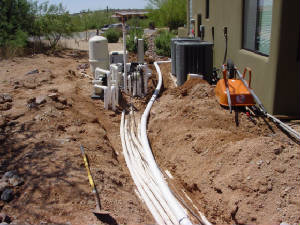
A: Yes we can! We also do business as Sonoran Image Landscapes and have
been Licensed Landscape contractors since 1995 . With more than thirty years experience in Landscape design, Installation
& Maintenance, We can help you create a beutiful Landscape whether you are needing a Desert, Tropical, Mediterranean
or Xeriscape theme. We can also renovate your existing Landscape, Irrigation & Outdoor Lighting systems & fix Drainage
or Erosioin problems in the process. From small patio yards to Large subdivisions, we have done it all!
Q: What is Xeriscape? A: Great question! Xeriscape is a method of Landscaping that conserves water by using native & drought tolerant plants & possibly a small island of grass lawn but still provides a lush appearance. Xeriscape has grown in popularity recently & continues to grow here in the Southwest & many other drought striken communities throughout the U.S. As water becomes more scarce we must find way's to cut back on all non essential water use. That is why many Homeowners, H.O.A's, Commercial & Municipalities are adapting thier Landscapes to Xeriscape. Most cities here in the Metro Phoenix area even offer a really nice rebate when removing Grass & converting to a water saving Desert or Xeriscape.
|
|||||||||||||||||||||||||||||||||||||||||||||||

